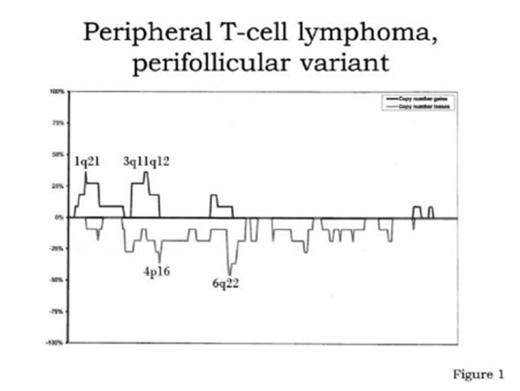Abstract
Perifollicular variant of peripheral T-cell lymphoma, UNS: a distinct lymphoma type with cytogenetic and clinical findings different from those of angio-immunoblastic lymphoma.
A. Bassarova, F. Micci, G. Trzen, H. Holte, J. Delabie
Peripheral T-cell lymphoma, unspecified (PTCL-U), represents approximately 30% of all peripheral T-cell lymphomas (PTCL) in adults, excluding primary cutaneous lymphomas. PTCL-U represents approximately 12–15% of lymphomas in the Western population. The disease has a five-year overall survival of about 30%. PTCL-U is currently an amalgam of T-cell lymphomas with a mature immunophenotype that cannot be classified into other well-characterized types of PTCL. However, within PTCL-U several variants are tentatively recognized, among which the follicular or perifollicular variant. This entity is histologically characterized by its localization within the B-cell area of the lymph node and by its T follicular helper cell immunophenotype. In view of the latter, it has been argued that the follicular variant of PTCL-U is an early stage of angio-immunoblastic T-cell lymphoma, a well-characterized type of PTCL of T follicular helper cell origin.
To better study perifollicar T-cell lymphoma as compared to AITL, we retrieved 47 cases of PTCL with these diagnoses from the archive of the Department of Pathology at Oslo University Hospital collected in a time period from 1999 to 2013 and reviewed the morphological, immunophenotypic, cytogenetic and clinical findings. Immunophenotypic analysis was completed when necessary. Diagnoses were made according to the W.H.O. criteria that included those published by our group previously. Cytogenetic data were available for 39 cases.
Nineteen cases of perifollicular TCL and 23 cases of AITL were retrieved and 4 cases with features between perifollicular TCL and AITL were identified. By cytogenetic analysis, perifollicular TCL showed a complex karyotype with structural and numerical abnormalities. The most frequently observed aberrations were loss of 4p16 and 6q22 as well as gains of 1q21 and 3q11q12 (Fig. 1). AITL was characterized by predominantly numerical chromosomal aberrations and less structural abnormalities. The most frequent detected abnormalities were gains of chromosome 3, 5, 7, 9 and 19 (Fig. 2).
The patients with perifollicular TCL had normal to high lymphocytic counts (p<0.05), platelet counts greater than 145 (p<0.001), normal LDH levels, albumin levels above the median (p<0.05) normal or slightly elevated sedimentation ratios (p<0.05), normal or above median hemoglobin levels (p<0.001) and infrequent bone marrow involvement at presentation. The majority of patients had international prognostic index (IPI) scores of 0, 1 or 2 (p<0.05) and a W.H.O. performance status between 0 and 2. Bulky disease as well as extranodal involvement at presentation was rare in this group of patients. By contrast patients with AITL presented with B-symptoms, high sedimentation ratios (p<0.05), lymphopenia (p<0.05), thrombocytopenia (p<0.001), elevated LDH and low hemoglobin levels (p<0.001) and hypoalbuminemia (p<0.05). The patients had IPI scores between 3 and 5 at presentation (p<0.05). All patients with AITL had bulky disease and 40 % had multiple extranodal localizations at presentation. Importantly, patients with perifollicular TCL showed better response to therapy and had significantly longer overall survival when compared with AILT (Fig. 3).
In conclusion, the cytogenetic findings showing a complex karyotype with predominantly structural alterations, the less severe symptoms and signs at presentation and the longer overall survival are features that distinguish perifollicular TCL from AITL. Together these features do not favor the hypothesis that perifollicular TCL is an early stage of AITL but indicate that perifollicular TCL is a distinct type of PTCL. The identification of four cases with histological features between those of perifollicular TCL and AITL in our series may indicate that better methods are needed to reliably separate these entities. Therefore, detailed genetic characterization of perifollicular TCL in comparison with AITL is currently being undertaken.
Schematic representation of the cytogenetic data of PTCL-perifollicular
No relevant conflicts of interest to declare.
Author notes
Asterisk with author names denotes non-ASH members.




